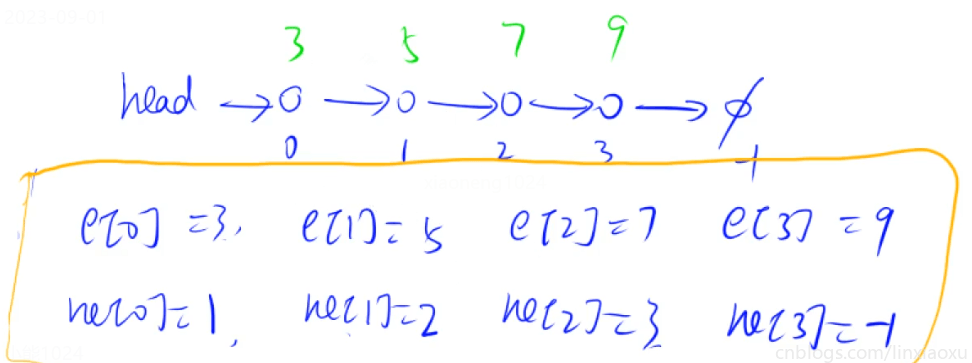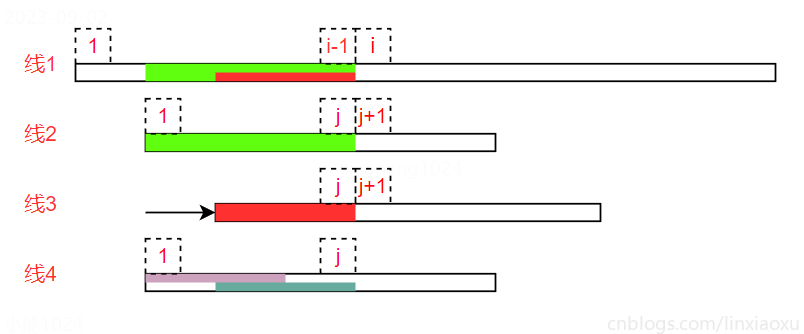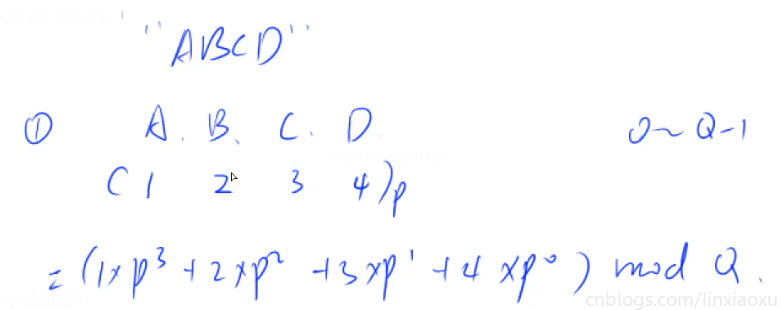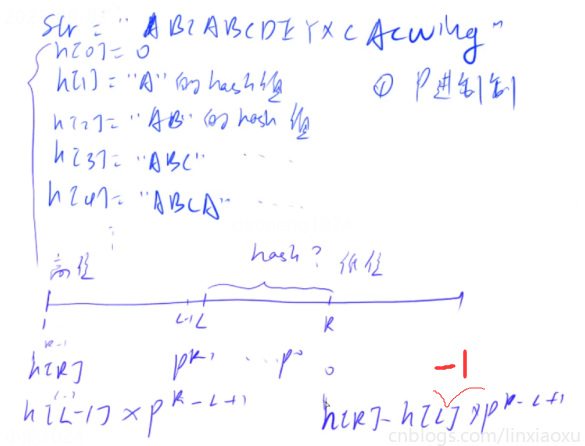C++算法之旅、05 基础篇 | 第二章 数据结构
笔试用数组模拟而不是结构体
使用结构体指针,new Node() 非常慢,创建10万个节点就超时了,做笔试题不会用这种方式(优化是提前初始化好数组,但这样跟数组模拟没区别了,而且代码量很长)
单链表(数组)
使用两个数组,e存储val,ne存储next。空节点next用-1表示

826
第1个插入的点下标为0,第5个插入点下标为4,第k个插入点下标为k-1;
#include <algorithm>
#include <cstdio>
#include <iostream>
using namespace std;
const int N = 1e5 + 10;
// head指向头结点,e[i]表示节点值,ne[i]表示节点next
// idx指向可用空间(当前可以用的最新点下标)
// 算法题不用考虑浪费的空间
int head, e[N], ne[N], idx;
void init() {
head = -1;
idx = 0;
}
// x 插到头结点后面
void add_to_head(int x) {
e[idx] = x;
ne[idx] = head;
head = idx++;
}
// x 插到下标k的点后面
void add(int k, int x) {
e[idx] = x;
ne[idx] = ne[k];
ne[k] = idx++;
}
// 将下标 k 后面点删掉
void remove(int k) {
// if (ne[k] == -1) return; 题目保证合法不考虑边界情况
ne[k] = ne[ne[k]];
}
int main() {
int m;
cin >> m;
init();
while (m--) {
char c;
int k, x;
cin >> c;
if (c == 'H') {
cin >> x;
add_to_head(x);
} else if (c == 'D') {
cin >> k;
if (!k)
head = ne[head]; // 特判删除头结点(链表第一个有效元素)
else
remove(k - 1);
} else if (c == 'I') {
cin >> k >> x;
add(k - 1, x);
}
}
for (int i = head; i != -1; i = ne[i]) {
cout << e[i] << " ";
}
return 0;
}
邻接表
本质是一堆单链表,head[i]->x->x->-1 意思第i个点的邻边存起来了
最大用途:存储图、树 (内容在第三章)
双链表(数组)
用于优化某些题,每个节点有两个指针,一个指向前,一个指向后
需要3个数组,l 数组表示before,r 数组表示next,e 数组表示val,idx指向可用空间
下标0为head,指向头结点(左端点);下标1为tail,指向尾结点(右端点)

827
因为提前用掉了数组中的两个,所以第k个插入元素下标是 k - 1 + 2
#include <algorithm>
#include <cstdio>
#include <iostream>
using namespace std;
const int N = 1e5 + 10;
int e[N], l[N], r[N], idx;
void init() {
r[0] = 1;
l[1] = 0;
idx = 2;
}
// 在下标k点的右边插入x(可以转化成左边)
void add(int k, int x) {
e[idx] = x;
r[idx] = r[k];
l[idx] = k;
r[k] = idx;
l[r[idx]] = idx;
idx++;
}
// 删除下标k的点
void remove(int k) {
l[r[k]] = l[k];
r[l[k]] = r[k];
}
int main() {
int m;
cin >> m;
init();
while (m--) {
string s;
int k, x;
cin >> s;
if (s == "L") {
cin >> x;
add(0, x);
} else if (s == "R") {
cin >> x;
add(l[1], x);
} else if (s == "D") {
cin >> k;
remove(k - 1 + 2);
} else if (s == "IL") {
cin >> k >> x;
add(l[k - 1 + 2], x);
} else if (s == "IR") {
cin >> k >> x;
add(k - 1 + 2, x);
}
}
for (int i = r[0]; i != 1; i = r[i]) {
cout << e[i] << " ";
}
return 0;
}
栈
830
先进后出。数据存储区间为[1,M],tt为栈顶指针
#include <algorithm>
#include <cstdio>
#include <iostream>
using namespace std;
const int N = 1e5 + 10;
int stk[N], tt;
int main() {
int m;
cin >> m;
while (m--) {
string s;
int x;
cin >> s;
if (s == "push") {
cin >> x;
stk[++tt] = x;
} else if (s == "pop") {
tt--;
} else if (s == "empty") {
if (tt > 0)
puts("NO");
else
puts("YES");
} else if (s == "query") {
cout << stk[tt] << endl;
}
}
return 0;
}
3302 数组
中缀转后缀的重要规则(强行记忆)。转换与计算可以同步进行(各自需要一个栈)
- 当前运算符优先级<=栈顶元素,则栈顶元素依次输出直到不满足条件,并当前符号进栈
- 遇到右括号,则栈顶元素依次输出直到左括号
- 遍历完成后弹出栈内剩余运算符
#include <algorithm>
#include <cstdio>
#include <iostream>
#include <unordered_map>
using namespace std;
const int N = 1e5 + 10;
int op[N], num[N], opt = -1, numt = -1;
unordered_map<char, int> priority;
// 计算后缀表达式
void eval() {
auto b = num[numt--];
auto a = num[numt--];
auto c = op[opt--];
int res;
if (c == '-')
res = a - b;
else if (c == '+')
res = a + b;
else if (c == '*')
res = a * b;
else if (c == '/')
res = a / b;
num[++numt] = res;
}
int main() {
priority = {{'-', 1}, {'+', 1}, {'*', 2}, {'/', 2}};
string str;
cin >> str;
for (int i = 0; i < str.size(); i++) {
if (isdigit(str[i])) {
int j = i, res = 0;
while (isdigit(str[j])) res = res * 10 + str[j++] - '0';
num[++numt] = res;
i = j - 1;
} else if (str[i] == '(')
op[++opt] = str[i];
else if (str[i] == ')') {
while (op[opt] != '(') eval();
opt--;
} else {
while (opt >= 0 && priority[str[i]] <= priority[op[opt]]) eval();
op[++opt] = str[i];
}
}
while (opt >= 0) eval();
cout << num[numt];
return 0;
}
3302 STL
#include <algorithm>
#include <cstdio>
#include <iostream>
#include <stack>
#include <unordered_map>
using namespace std;
stack<int> num;
stack<char> op;
void eval() {
auto b = num.top();
num.pop();
auto a = num.top();
num.pop();
auto c = op.top();
op.pop();
int x;
if (c == '+')
x = a + b;
else if (c == '-')
x = a - b;
else if (c == '*')
x = a * b;
else
x = a / b;
num.push(x);
}
int main() {
unordered_map<char, int> pr{{'+', 1}, {'-', 1}, {'*', 2}, {'/', 2}};
string str;
cin >> str;
for (int i = 0; i < str.size(); i++) {
auto c = str[i];
if (isdigit(c)) {
// 第一类双指针
int x = 0, j = i;
while (j < str.size() && isdigit(str[j]))
x = x * 10 + str[j++] - '0';
i = j - 1; // 考虑i++
num.push(x);
} else if (c == '(')
op.push(c);
else if (c == ')') {
while (op.top() != '(') eval();
op.pop();
} else {
while (op.size() && pr[op.top()] >= pr[c]) eval();
op.push(c);
}
}
while (op.size()) eval();
cout << num.top() << endl;
return 0;
}
队列
829
829. 模拟队列 - AcWing题库 队尾插入,队头输出
#include <algorithm>
#include <cstdio>
#include <iostream>
using namespace std;
const int N = 1e5 + 10;
int que[N], st = -1, ed = -1;
int main() {
int m;
cin >> m;
while (m--) {
string str;
int x;
cin >> str;
if (str == "push") {
cin >> x;
que[++ed] = x;
} else if (str == "pop") {
st++;
} else if (str == "empty") {
if (st == ed)
puts("YES");
else
puts("NO");
} else if (str == "query") {
cout << que[st + 1] << endl;
}
}
return 0;
}
单调栈
830
朴素做法是两层循环。
使用栈,满足情况:当下标为 i,栈内元素为 \(a_1,a_2...a_i\)
单调栈要求遍历数组过程中,维护栈,满足栈底至栈顶元素呈单调性(依次递增)
- 栈内 \(a_1\)~\(a_i\) 递增,此时遍历至 \(a_{i+1}\),将小于 \(a_{i+1}\) 的栈内元素删除,再插入 \(a_{i+1}\)
- 每个元素一次,出栈一次,\(O(n)\)
scanf 与 cin 速度差了十倍左右,使用 cin.tie(0) 或 ios::sync_with_stdio(false) 加速
#include <algorithm>
#include <cstdio>
#include <iostream>
using namespace std;
const int N = 1e5 + 10;
int n;
int stk[N], tt;
int main() {
cin.tie(0);
// ios::sync_with_stdio(false);
int n;
cin >> n;
for (int i = 0; i < n; i++) {
int x;
cin >> x;
while (tt && stk[tt] >= x) tt--;
if (tt)
cout << stk[tt] << " ";
else
cout << -1 << " ";
stk[++tt] = x;
}
return 0;
}
单调队列
154
朴素算法是 \(O(n^2)\)
单调队列要求滑动窗口每滑动一次时,将窗口内 >= \(a_i\) 的元素从队尾删除(类似单调栈),\(a_i\) 入队,该队列将保持单调递增,此时对头点为最小值。注意队列里存的是下标
#include <algorithm>
#include <cstdio>
#include <iostream>
using namespace std;
const int N = 1e6 + 10;
int a[N], q[N], st = 0, ed = -1;
int main() {
cin.tie(0);
int n, k;
cin >> n >> k;
for (int i = 0; i < n; i++) {
cin >> a[i];
}
for (int i = 0; i < n; i++) {
// 移动队头
if (st <= ed && i - k + 1 > q[st]) st++;
// 移动队尾
while (st <= ed && a[q[ed]] >= a[i]) ed--;
// ^ 先插入
q[++ed] = i;
// 每次滑动输出
if (i >= k - 1) printf("%d ", a[q[st]]);
}
cout << endl;
st = 0;
ed = -1;
for (int i = 0; i < n; i++) {
if (st <= ed && i - k + 1 > q[st]) st++;
while (st <= ed && a[q[ed]] <= a[i]) ed--;
q[++ed] = i;
if (i >= k - 1) printf("%d ", a[q[st]]);
}
return 0;
}
KMP
一个人能走多远不在于他在顺境时能走的多快,而在于他在逆境时多久能找到曾经的自己
强烈建议看 胡凡 算法笔记 P455

假设下标从1开始。字符串 S[1,N],子串 P[1,M],S 指针 i-1,P 指针 j
next[j]
- 子串中,以 j 为终点的后缀 与 从1开始的前缀相等的最长长度 x
- \(P[1,x] = P[j-x+1,j]\)
kmp 建议看算法笔记
- i-1 与 j 对应字符相同;i 与 j+1 对应字符不同。此时需要把红颜色子串往后移动,为了移动最少需要 next[j]
- 让 j = next[j],从线2变为线3(线1红色部分 等于 线3红色部分)
- 继续匹配 i 与 j+1,若发现不匹配,再 j = next[j] (递归进行)
- 当 j = m,意味着找到子串,然后 j = next[j] 继续寻找
时间复杂度计算
- 生成next数组 \(O(m)\)
- 字符串每个字符被遍历一次,\(O(n)\)
- j++ 最多 n 次,最多减 n 次,\(O(n)\)
831
next 在某些头文件里有定义,最好换个变量名;另外KMP算法还可以进一步优化,以下是优化后的算法
#include <algorithm>
#include <cstdio>
#include <iostream>
using namespace std;
const int N = 1e5 + 10;
const int M = 1e6 + 10;
int next_val[N];
int main() {
int n, m;
char p[N], s[M];
cin >> n >> p + 1 >> m >> s + 1;
// ^ 生成 next_val 数组
for (int i = 2, j = 0; i <= n; i++) {
while (j && p[i] != p[j + 1]) j = next_val[j];
if (p[i] == p[j + 1]) j++;
// ^ 继续优化,选择回退的最佳位置
if (j && p[i + 1] == p[j + 1]) {
next_val[i] = next_val[j];
} else
next_val[i] = j;
}
// for (int i = 1; i <= n; i++) {
// cout << next_val[i] << endl;
// }
// ^ KMP 匹配过程
for (int i = 1, j = 0; i <= m; i++) {
while (j && p[j + 1] != s[i]) j = next_val[j];
if (p[j + 1] == s[i]) j++;
if (j == n) {
cout << i - n << " ";
j = next_val[j];
}
}
return 0;
}
字典树 Trie
用于高效存储和查找字符串集合的数据结构
835
son[N][26] 存的是每个节点所有的儿子是什么,cnt[N] 存的是单词的数量,idx与数组模拟单链表里的idx相同
#include <algorithm>
#include <cstdio>
#include <iostream>
using namespace std;
const int N = 1e5 + 10;
int son[N][26], cnt[N], idx; // ^ 下标是0的点,既是根节点又是空节点
void insert(char str[]) {
int p = 0;
for (int i = 0; str[i]; i++) {
int u = str[i] - 'a';
if (!son[p][u]) son[p][u] = ++idx;
p = son[p][u];
}
cnt[p]++;
}
int query(char str[]) {
int p = 0;
for (int i = 0; str[i]; i++) {
int u = str[i] - 'a';
if (!son[p][u]) return 0;
p = son[p][u];
}
return cnt[p];
}
int main() {
cin.tie(0);
int n;
cin >> n;
while (n--) {
char a, b[N];
cin >> a >> b;
if (a == 'I')
insert(b);
else
cout << query(b) << endl;
}
return 0;
}
143
朴素算法是两层循环并满足 j<i(避免重复, \(C^2_n = n*(n-1)/2\) );时间复杂度 \(O(n^2)\) ,题目给的 n 是 1e5,则 1e10 超时
可以使用 trie tree 优化,每插入一个元素 x,在字典树中查找满足与该元素异或最大值的元素(尽可能反着取,每次查找只要遍历31位),时间复杂度 \(O(n)\)
可以先插入再遍历(少个判断),第一个插入的元素与自身异或为 0
每个节点个数长31,最多1e5个,那么idx最大可以到 31 * 1e5
#include <algorithm>
#include <cstdio>
#include <iostream>
using namespace std;
const int N = 1e5 + 10, M = 31 * N;
int son[M][2], idx;
void insert(int x) {
int p = 0;
for (int i = 30; i >= 0; i--) {
int bit = x >> i & 1;
if (!son[p][bit]) son[p][bit] = ++idx;
p = son[p][bit];
}
}
int query(int x) {
int res = 0, p = 0;
for (int i = 30; i >= 0; i--) {
int bit = x >> i & 1;
if (son[p][!bit]) {
bit = !bit;
}
p = son[p][bit];
res = (res << 1) + bit;
}
return res;
}
int main() {
int n;
cin >> n;
int m = 0;
while (n--) {
int x;
cin >> x;
insert(x);
m = max(x ^ query(x), m);
}
cout << m;
return 0;
}
并查集
操作
- 将两个集合合并
- 询问两个元素是否在一个集合当中
朴素算法下,合并两个集合需要执行\(O(n+m)\)次;并查集可以近乎\(O(1)\)合并两个集合
基本原理
- 用树的形式维护所有集合;根节点是集合编号
- 每个节点存储父节点,p[x] 表示x的父节点
如何判断树根
if (p[x] == x),根节点的父节点是它本身
如何求x的集合编号
while(p[x] != x) x = p[x]- 路径压缩 :往上走找到根节点把路径所有点都指向跟节点
如何合并两个集合 记住模板
p[x] = y,将一颗树根节点插到另一棵树的某个位置
int find(int x) {
if (p[x] != x) p[x] = find(p[x]);
return p[x];
}
如何维护集合元素个数(携带额外信息)
- 见837题
836
#include <algorithm>
#include <cstdio>
#include <iostream>
using namespace std;
const int N = 1e5 + 10;
int p[N];
// ^ 返回x祖宗节点 + 路径压缩
int find(int x) {
if (p[x] != x) p[x] = find(p[x]);
return p[x];
}
int main() {
cin.tie(0);
int n, m;
cin >> n >> m;
for (int i = 1; i <= n; i++) p[i] = i;
while (m--) {
char op;
int a, b;
cin >> op >> a >> b;
if (op == 'M') {
p[find(a)] = find(b);
} else {
if (find(a) == find(b))
puts("Yes");
else
puts("No");
}
}
return 0;
}
837
保证根节点的nums有意义
#include <algorithm>
#include <cstdio>
#include <iostream>
using namespace std;
const int N = 1e5 + 10;
int p[N], nums[N];
int find(int x) {
if (p[x] != x) p[x] = find(p[x]);
return p[x];
}
int main() {
cin.tie(0);
int n, m;
cin >> n >> m;
for (int i = 1; i <= n; i++) {
p[i] = i;
nums[i] = 1;
}
while (m--) {
string op;
int a, b;
cin >> op;
if (op == "C") {
cin >> a >> b;
// ^ 特判
if (find(a) == find(b)) continue;
// ^ 先算元素个数再合并
nums[find(b)] += nums[find(a)];
p[find(a)] = find(b);
} else if (op == "Q1") {
cin >> a >> b;
if (find(a) == find(b))
puts("Yes");
else
puts("No");
} else if (op == "Q2") {
cin >> a;
cout << nums[find(a)] << endl;
}
}
return 0;
}
240
确定每个动物跟领袖(n对1)的关系,而不是动物跟动物(n对n)的关系
维护每个节点与根节点的距离(x吃y,y到x距离是1),然后 % 3 判断类型。初始化每个节点都是0,各自一类。
- 余1:可以吃根节点
- 余2:可以被根节点吃
- 余0:与根节点是同类
#include <algorithm>
#include <cstdio>
#include <iostream>
using namespace std;
const int N = 1e5 + 10;
int p[N], d[N];
int find(int x) {
if (p[x] != x) {
// 递归处理所有祖宗节点,并更新到根的距离
int t = find(p[x]);
// d[x] 等于 x到父的距离 + 父到根的距离(递归处理完了)
d[x] += d[p[x]];
// x 的父修改为根节点,路径优化
p[x] = t;
// // 记录旧的父
// int u = p[x];
// // 路径压缩,新父根节点
// p[x] = find(p[x]);
// // x到根的距离等于x到旧父距离加上旧父到根的距离
// d[x] += d[u];
}
return p[x];
}
int main() {
cin.tie(0);
int n, k;
cin >> n >> k;
for (int i = 1; i <= n; i++) p[i] = i;
int count = 0;
while (k--) {
char t;
int x, y;
cin >> t >> x >> y;
if (x > n || y > n) {
count++;
} else {
int px = find(x), py = find(y);
if (t == '1') {
if (px == py && (d[x] - d[y]) % 3 != 0)
count++;
else if (px != py) {
p[px] = py;
d[px] = d[y] - d[x]; // IMPORTANT
}
} else {
if (x == y || px == py && (d[x] - d[y] - 1) % 3 != 0) {
count++;
} else if (px != py) {
p[px] = py;
d[px] = d[y] + 1 - d[x];
}
}
}
}
cout << count << endl;
return 0;
}
堆
小根堆
每个点 <= 左右儿子,根节点就是树的最小值 。
完全二叉树用一维数组存:x 的左儿子 2x,x 的右儿子 2x+1;下标从1开始
两个操作
- down(x) 往下调整 (x是坐标 1 ~ size) \(O(log_2n)\)
- 每次找{ x,x左子,x右子 }的最小值,进行交换
- up(x) 往上调整 \(O(log_2n)\)
- 每次找{ x,x父 }的最小值,进行交换
堆的功能
- 插入一个数 \(O(log_2n)\)
heap[++size] = x然后不断往上移up(size)
- 求集合当中的最小值 \(O(1)\)
heap[1]
- 删除最小值 \(O(log_2n)\)
heap[1] = heap[size--]堆最后一个元素覆盖堆顶元素,然后down(1)- 因为删除头结点非常困难,删除尾结点很easy
- 删除任意一个元素(STL没直接实现,优先队列) \(O(log_2n)\)
heap[k] = heap[size--]有三种情况,可直接down(k)再up(k),只会执行一个
- 修改任意一个元素(STL没直接实现,优先队列) \(O(log_2n)\)
heap[k] = x再down(k)、up(k)
838
一个一个往里插是 \(O(nlog_2n)\) 。可以采用 \(O(n)\) 的方式,先全部读入,除最后一层外反着down操作(倒第2层,倒第3层...第1层)(可用数列推导出,每个节点down的次数总和 < n)(记忆)
for (int i = n / 2; i; i--) {
down(i);
}
#include <algorithm>
#include <cstdio>
#include <iostream>
using namespace std;
const int N = 1e5 + 10;
int n, m;
int h[N], idx;
void down(int u) {
int t = u;
if (u * 2 <= idx && h[u * 2] < h[t]) t = u * 2;
if (u * 2 + 1 <= idx && h[u * 2 + 1] < h[t]) t = u * 2 + 1;
if (u != t) {
swap(h[t], h[u]);
down(t);
}
}
int main() {
cin.tie(0);
cin >> n >> m;
int x;
for (int i = 1; i <= n; i++) {
cin >> h[i];
}
idx = n;
for (int i = n / 2; i; i--) {
down(i);
}
while (m--) {
cout << h[1] << " ";
h[1] = h[idx--];
down(1);
}
return 0;
}
839
存储映射:ph 存第k个插入的点在堆里的下标,hp 存堆里点的坐标是第k个插入的,两者互为相反关系。
#include <algorithm>
#include <cstdio>
#include <iostream>
using namespace std;
const int N = 1e5 + 10;
int h[N], hp[N], ph[N], idx;
void new_swap(int a, int b) {
swap(ph[hp[a]], ph[hp[b]]);
swap(hp[a], hp[b]);
swap(h[a], h[b]);
}
void up(int x) {
while (x / 2 && h[x / 2] > h[x]) {
new_swap(x / 2, x);
x /= 2;
}
}
void down(int x) {
int t = x;
if (2 * x <= idx && h[2 * x] < h[t]) t = 2 * x;
if (2 * x + 1 <= idx && h[2 * x + 1] < h[t]) t = 2 * x + 1;
if (t != x) {
new_swap(x, t);
down(t);
}
}
int main() {
cin.tie(0);
int n;
cin >> n;
int count = 0;
while (n--) {
string s;
int k, x;
cin >> s;
if (s == "I") {
cin >> x;
idx++;
count++;
h[idx] = x;
hp[idx] = count;
ph[count] = idx;
up(idx);
} else if (s == "PM") {
cout << h[1] << endl;
} else if (s == "DM") {
// ^ h[1] = h[idx--]; // 这样只交换点,没交换ph hp
new_swap(1, idx--);
down(1);
} else if (s == "D") {
cin >> k;
// ^ h[ph[k]] = h[idx--]; // 这样只交换点,没交换ph hp
k = ph[k]; // 获取第k个插入的数在堆中的坐标
new_swap(k, idx--);
down(k), up(k); // 只会执行其中一个
} else if (s == "C") {
cin >> k >> x;
k = ph[k];
h[k] = x;
down(k), up(k);
}
}
return 0;
}
哈希表
情景
- 把 1e5 个值域 -1e9~1e9 的数(值域大,个数少)映射到 1e5 的范围的哈希函数
- \(h(x) \in (0,1e5) = x\ mod\ 1e5\) 模数一般要取质数,离2的整数幂尽可能远
- 发生冲突:两个不同值域的数映射成了同一个数
存储结构-解决冲突的方式
算法题99%一般只有添加、查找,若要实现删除不会真删掉,开一个bool数组标记删除
- 开放寻址法(常用)
- 开一个一维数组,范围是题目数据范围的2~3倍,即 2e5 ~ 3e5 区间的质数,该数组存储实际的 x 值
- 计算哈希值,如果哈希值已被占用,则移动到下一个位置,从前往后找
- h(11) = 3 在 数组[3] 存入 11,h(4) = 3 在数组[4] 存入 4
- 与拉链法不同,查询函数返回 x 所在的位置,如果 x 不存在返回应该存储的位置
- 需要约定一个标志,不在 x 的值域范围内,表示当前位置为空,如 0x3f3f3f3f
- 拉链法
- 开一个一维数组 \([0,大于1e5的最小质数]\) 存储所有哈希值对应的链表
- h(11) = 3 在 数组[3] 开一条链,插入 11
- 若 h(4) = 3 在 数组[3] 已开的链插入 4
- 期望情况下,每条链长度 1,时间复杂度 \(O(1)\)
字符串哈希-字符串前缀哈希法(特殊)
应用:可以快速判断一个字符串某两段是否相同。KMP望而却步(KMP擅长循环节),极困难题可用这种方法
先预处理所有前缀的哈希,h[0] = 0, h[1] = "A" 的hash,h[2] = "AB" 的hash...
- 把字符串看成 P 进制的数,然后模 Q

**某个字符不能映射成 0,否则 AA 跟 A 两个哈希都是 0 **
该哈希法假定人品足够好,不考虑冲突
经验值:当 p = 131 或 13331,Q 取 \(2^{64}\) (用 unsinged long long可以不取模,溢出相当于取模)
我们可以利用前缀哈希算出任意子段的哈希值
- 预处理前缀
h(i) = h(i-1) * p + str[i]

与整数离散化的区别
整数离散化需要保序,而且不会发生冲突,每一个元素都有唯一确定的位置(1 ~ n)
840 拉链法
h 数组维护 N 条链,空节点表示-1,e 数组与 ne 数组维护链上的每一个节点,idx为每个节点分配唯一标识符;插入操作从链表头结点插入
#include <algorithm>
#include <cstdio>
#include <cstring>
#include <iostream>
using namespace std;
const int N = 1e5 + 3; // 质数
int h[N], e[N], ne[N], idx;
void insert(int x) {
// 第一次模余数可能是负数,第二次模余数绝对是正数
int k = (x % N + N) % N;
e[idx] = x;
ne[idx] = h[k];
h[k] = idx++;
}
bool find(int x) {
int k = (x % N + N) % N;
for (int i = h[k]; i != -1; i = ne[i])
if (e[i] == x) return true;
return false;
}
int main() {
cin.tie(0);
memset(h, -1, sizeof h);
int n;
cin >> n;
while (n--) {
string s;
int x;
cin >> s >> x;
if (s == "I")
insert(x);
else {
if (find(x))
puts("Yes");
else
puts("No");
}
}
return 0;
}
840 开放寻址法
#include <algorithm>
#include <cstdio>
#include <cstring>
#include <iostream>
using namespace std;
const int N = 2e5 + 3, null = 0x3f3f3f3f; // 质数
int h[N];
int find(int x) {
int k = (x % N + N) % N;
while (h[k] != null && h[k] != x) {
k++;
if (k == N) k = 0; // 查到数组最后从开头找
}
return k;
}
int main() {
cin.tie(0);
memset(h, 0x3f, sizeof h);
int n;
cin >> n;
while (n--) {
string s;
int x;
cin >> s >> x;
int k = find(x);
if (s == "I")
h[k] = x;
else {
if (h[k] != null)
puts("Yes");
else
puts("No");
}
}
return 0;
}
841 字符串哈希
如下的朴素算法会超时
#include <algorithm>
#include <cstdio>
#include <iostream>
using namespace std;
int main() {
cin.tie(0);
string s;
int n, m, l1, l2, r1, r2;
cin >> n >> m >> s;
while (m--) {
cin >> l1 >> r1 >> l2 >> r2;
l1 -= 1, l2 -= 1, r1 -= 1, r2 -= 1;
if (s.substr(l1, r1 - l1 + 1) == s.substr(l2, r2 - l2 + 1))
puts("Yes");
else
puts("No");
}
return 0;
}
p 数组提前存储预处理的 p 次方的值,减少计算量
#include <algorithm>
#include <cstdio>
#include <iostream>
using namespace std;
typedef unsigned long long ULL;
const int N = 1e5, P = 131;
int n, m;
char str[N];
ULL h[N], p[N];
ULL get(int l, int r) { return h[r] - h[l - 1] * p[r - l + 1]; }
int main() {
cin.tie(0);
cin >> n >> m >> str + 1;
p[0] = 1;
for (int i = 1; i <= n; i++) {
p[i] = p[i - 1] * P;
h[i] = h[i - 1] * P + str[i];
}
while (m--) {
int l1, r1, l2, r2;
cin >> l1 >> r1 >> l2 >> r2;
if (get(l1, r1) == get(l2, r2))
puts("Yes");
else
puts("No");
}
return 0;
}
STL
size()、empty() 所有容器都有,时间复杂度 \(O(1)\)
clear() 并不是所有容器都有,队列、优先队列、栈;范围遍历可以遍历所有容器
系统为某一个程序分配空间时,所需的时间与空间大小无关,与申请次数有关
vector
变长数组,倍增,支持比较运算(字典序(4个3小于3个4))。有erase但用得不多
插入操作\(O(1)\):插入1e6次,申请空间的次数 \(log_21e6\) ,拷贝的次数均摊是 1 (数组大小从1到1e6,总共拷贝次数是1e6(1+2+4+8+...))
#include <iostream>
#include <vector>
using namespace std;
int main() {
// ^ 定义一个长度为10的vector,每个数都是3
vector<int> a(10, 3);
vector<int> b[10];
a.push_back(1);
cout << a.size() << endl;
cout << a.empty() << endl;
a.clear();
cout << a.front() << endl;
cout << a.back() << endl;
// a.begin(); // ^ 返回的是迭代器(指针),需要解引用
// a.end();
return 0;
}
pair
二元组,支持比较运算(字典序)。适用于某种东西有两个属性,也可以存储三个属性,任意嵌套
相比结构体:pair 帮我们实现了结构体,并实现了比较函数,省了点代码
#include <iostream>
using namespace std;
int main() {
pair<int, pair<int, string>> a;
pair<int, string> p;
p = {20, "abc"};
p.first;
p.second;
return 0;
}
string
字符串,substr(起始位置,长度)、c_str()
#include <cstdio>
#include <iostream>
using namespace std;
int main() {
string a = "yxc";
a += "def";
a += "c";
// 从哪开始,返回多长(可省略)
cout << a.substr(1, 2) << endl;
printf("%s\n", a.c_str());
return 0;
}
queue
队列,push()、front()、pop(),没有 clear()
int main() {
queue<int> q;
// ^ 没有clear的清空方法
q = queue<int>();
return 0;
}
deque
双端队列,支持随机访问 []。相当于加强版 vector。效率较低,不常用
front、back、push_back、pop_back、push_front、pop_front
priority_queue
优先队列,默认是大根堆。push()、top()、pop()。头文件queue
int main() {
priority_queue<int> heap;
// ^ 定义小根堆
// 方式 1 每次插入负数
// heap.push(-x);
// 方式 2 多加两个参数
priority_queue<int, vector<int>, greater<int>> heap;
return 0;
}
stack
栈,push()、top()、pop();与队列用法类似
set、map、multiset、multimap
基于平衡二叉树(红黑树),动态维护有序序列。begin、end支持++、--操作,返回前驱后继(有序序列的前一个数或后一个数)。增删改查大部分 \(O(log_2n)\)
#include <iostream>
#include <set>
using namespace std;
int main() {
set<int> s;
multiset<int> ms;
s.insert(1);
// 找不到返回 end 迭代器
s.find(1);
// 返回某个数的个数
s.count(1);
// 删除所有等于这个数的节点 O(k + logn) k是x的个数
ms.erase(1);
// 删除这个迭代器
ms.erase(ms.find(1));
// 大于等于 x 的最小的数的迭代器,不存在返回end
s.lower_bound(0);
// 大于 x 的最小的数的迭代器,不存在返回end
s.upper_bound(0);
return 0;
}
#include <iostream>
#include <map>
using namespace std;
int main() {
map<string, int> a;
a.insert({"abc", 123});
// erase 跟 set 一样
// 可以像数组一样用 map,时间复杂度 O(logn)
count << a["abc"] << endl;
// 也支持 lower_bound、upper_bound
return 0;
}
unordered_
没有顺序,基于哈希表实现。与上面类似。但增删改查时间复杂度是 \(O(1)\)
不支持 lower_bound、upper_bound;不支持迭代器 ++ --
bitset
压位。C++里bool是1字节,如果要开1024个bool数组需要1024个字节,如果用压位,只需要128B
1e4 * 1e4 布尔矩阵,需要 1e8B,约100MB,题目给的 64MB,用压位可以缩小到12MB
int main() {
bitset<10000> s;
// ~ & | ^ >> << == != []
// count() 返回有多少个 1
// any() 判断是否至少有1个 1
// none() 判断是否全为 0
// set() 把所有位置1
// set(k,v) 将第k位变成v
// reset() 把所有位变成0
// flip() 等价于 ~
// flip(k) 把第k位取反
return 0;
}
C++算法之旅、05 基础篇 | 第二章 数据结构的更多相关文章
- Java语言程序设计(基础篇)第二章
第二章 基本程序设计 2.2 编写简单的程序 1.变量名尽量选择描述性的名字(descriptive name). 2.实数(即带小数点的数字)在计算机中使用一种浮点的方法来表示.因此,实数也称为浮点 ...
- 从零开始的程序逆向之路基础篇 第二章——用OllyDbg(OD)分析一个简单的软件
作者:Crazyman_Army 原文来自:https://bbs.ichunqiu.com/thread-43469-1-1.html 0x00知识回顾 (由于笔者省事,没开XP虚拟机,而且没关闭A ...
- Java编程基础篇第二章
关键字 概述:被Java语言赋予特定含义的单词. 特点:组成关键字的字母全部为小写字母. 标识符 概述:给类,接口,包,方法,常量起名字时的字符序列 组成规则:英文大小写字母,数字,$和— 命名规则. ...
- 实现 RSA 算法之 C 语言实现(第二章)(老物)
第二章 如何实现应用RSA算法 趁着白天在自家店里的闲暇时间来写写第二章了,假设记住了第一章的各种定理之后,我们又该如何实现RSA密码的加密解密呢?也懒得废话了,直接进入正题吧. 先回顾几个知识点: ...
- 第十三章 Python基础篇结束章
从2019年3月底开始学习Python,4月份开始在CSDN发博客,至今不到半年,老猿认为博客内容中关于Python基础知识的内容已经基本告一段落,本章进入Python基础知识结束章节,对Python ...
- sql系列(基础)-第二章 限制和排序数据
更好的看↑代码点击VIEW PLAN 第二章 约束和排序数据 1. 在 emp 表中选择工资介于 1500 到 2500 的员工的信息: 注意:使用 between 下边界 and 上边界时.条件包括 ...
- 05 | 基础篇:某个应用的CPU使用率居然达到100%,我该怎么办?
通过前两节对平均负载和 CPU 上下文切换的学习,我相信你对 CPU 的性能已经有了初步了解.不过我还是想问一下,在学这个专栏前,你最常用什么指标来描述系统的 CPU 性能呢?我想你的答案,可能不是平 ...
- Python ( 学习基础篇 第二部 )
目录 运算符 算数运算符 比较运算符 赋值运算符 位运算符 逻辑运算符 成员运算符 身份运算符 Python 中运算符的优先级 运算符总结基础语法 判断类型 isinstence 代码块 流程控制 w ...
- python基础教程-第二章-列表和元组
本章将引入一个新的概念,:数据结构.数据结构是通过某种方式(例如对元素进行编号)组织在 一起的数据元素的集合,这些数据元素可以是数字或者字符,甚至可以是其他数据结构.在python中,最基本的数据结构 ...
- Java编程基础篇第一章
计算机语言 人与计算机交流的方式. 计算机语言有很多种如:C语言,c++,Java等 人机交互 软件的出现实现了人与计算机之间的更好的交流(交互) 交互方式 图形化界面:便于交互,容易操作,简单直观, ...
随机推荐
- MySQL之视图,索引,存储过程,触发器--实操
一.视图 什么是视图? 视图是一个虚拟表,其内容由查询定义. 同真实的表一样,视图包含系列带有名称的列和行数据. 行和列数据来自定义视图的查询所引用的表,并且在引用视图时动态生成. 简单的来说视图是由 ...
- 今天在内部 Galaxy 分析平台操作探针引物设计小工具程序,调用 Ensembl API 获取相关序列和信息时,发现官网 MySQL server 异常,报告问题后当天晚上就收到了回复,并且修......
本文分享自微信公众号 - 生信科技爱好者(bioitee).如有侵权,请联系 support@oschina.cn 删除.本文参与"OSC源创计划",欢迎正在阅读的你也加入,一起分 ...
- 可以,很强,68行代码实现Bean的异步初始化,粘过去就能用。
你好呀,我是歪歪. 前两天在看 SOFABoot 的时候,看到一个让我眼前一亮的东西,来给大家盘一下. SOFABoot,你可能不眼熟,但是没关系,本文也不是给你讲这个东西的,你就认为它是 Sprin ...
- 逍遥自在学C语言 | 枚举的那些事儿
前言 在C语言中,枚举是一种方便组织和表示一组相关常量的工具.枚举类型有助于提高代码的可读性和可维护性.本文将介绍C语言枚举的基本概念.语法和用法,以及一些高级技巧. 一.人物简介 第一位闪亮登场,有 ...
- substrate 编译出错unresolved import `sp_runtime::testing` failed to resolve: could not find `GenesisConfig` in `system`
error[E0432]: unresolved import `sp_runtime::testing` --> /Users/suyinrong/bitcoin-proj/substrate ...
- in用不用索引,啥时候能用啥时候不能用,一文说清
in/or到底能不能用索引应该是肯定的,但有时生效有时不生效,这个能不能量化计算?这是本文想讨论和解答的问题. in到底用不用索引感觉像一桩悬疑片!古早时期的面经,统一说不走索引,在一些程序员脑海中从 ...
- 图书商城Vue+Element+Node项目练习(...)
本系列文章是为学习Vue的项目练习笔记,尽量详细记录一下一个完整项目的开发过程.面向初学者,本人也是初学者,搬砖技术还不成熟.项目在技术上前端为主,包含一些后端代码,从基础的数据库(Sqlite).到 ...
- 使用Kettle定时从数据库A刷新数据到数据库B
一.需求背景 由于项目场景原因,需要将A库(MySQL)中的表a.表b.表c中的数据定时T+1 增量的同步到B库(MySQL).这里说明一下,不是数据库的主从备份,就是普通的数据同步.经过技术调研,发 ...
- 【原创】xenomai内核解析-xenomai实时线程创建流程
版权声明:本文为本文为博主原创文章,未经同意,禁止转载.如有错误,欢迎指正,博客地址:https://www.cnblogs.com/wsg1100/ 目录 问题概述 1 libCobalt中调用非实 ...
- 从头学Java17-Stream API(一)
Stream API Stream API 是按照map/filter/reduce方法处理内存中数据的最佳工具. 本系列中的教程包含从基本概念一直到collector设计和并行流. 在流上添加中继操 ...
